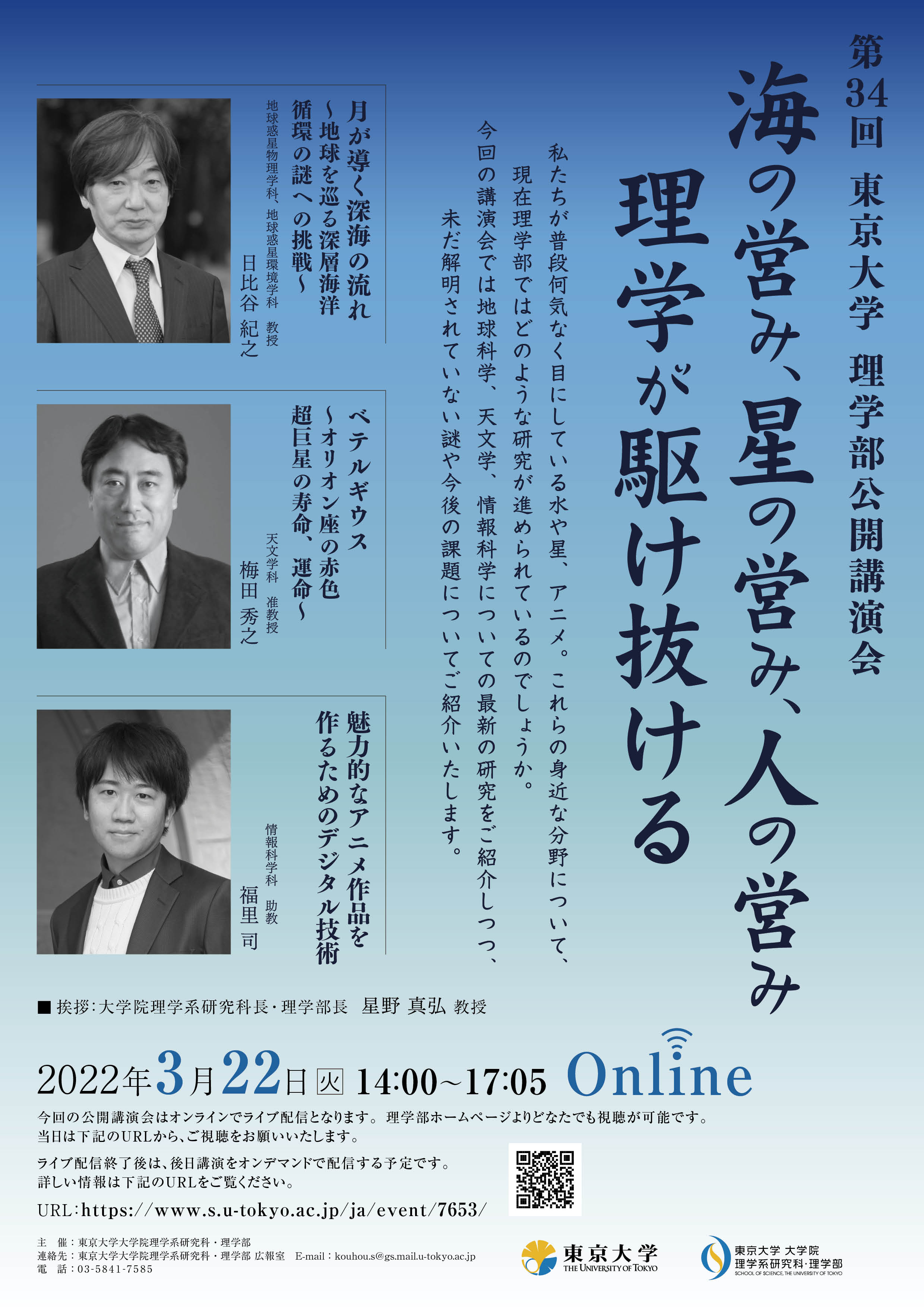DATE2022.01.20 #Events
Disclaimer: machine translated by DeepL which may contain errors.
The Life of the Sea, the Life of the Stars, and the Life of Human Beings
Rhythm runs through it."
Water, stars, and animation are things we see without thinking about them. What kind of research is currently being conducted at the Faculty of Science in these familiar fields?
In this lecture, we will introduce the latest research in earth science, astronomy, and information science, as well as the mysteries that have yet to be solved and the challenges that lie ahead.
The slide presentation (PDF) is no longer available.
- Hideyuki Umeda (Associate Professor, Department of Astronomy)
- Tsukasa Fukusato (Assistant Professor, Department of Information Science)
Speakers
Deep Ocean Currents Guided by the Moon: Challenges to the Mystery of Deep Ocean Circulation Around the Earth
Noriyuki Hibiya (Professor, Department of Earth and Planetary Physics, Department of Earth and Planetary Environmental Science)

Deep water, which is strongly cooled and deposited in the polar regions, travels around the globe for about 1,500 years, upwells in the Indian and North Pacific Oceans, and returns to the polar regions, forming a deep ocean circulation like a conveyor belt. The heat transport from low latitudes to high latitudes associated with the circulation plays an important role in the formation of the Earth's temperate climate. Although buoyancy injection from the surface to the deep layer by turbulent mixing is considered essential for upwelling of deep water necessary to maintain this circulation, turbulent mixing has not yet been found to upwelling all deep water, which is estimated to sink 20 million tons per second, to the surface (Missing Mixing). In this presentation, I will introduce the important role of the moon (tides) in the formation of this turbulent mixing as well as the challenge to solve the mystery of the Missing Mixing.
Betelgeuse -Life and Fate of the Red Supergiant Star in Orion
Hideyuki Umeda, Associate Professor, Department of Astronomy

Betelgeuse is a famous first-magnitude star that forms part of the Winter Triangle. Since then, the brightness has returned to normal, and some researchers believe that the star will not explode for the next 100,000 years or so, so the fuss seems to have died down. In this talk, I will give a general explanation of stellar evolution and then compare the latest theoretical calculations with observations to see what can be said about the life and fate of Betelgeuse.
Digital Technology for Creating Attractive Animation Works
Tsukasa Fukusato (Assistant Professor, Department of Information Science)

The method in which the designer draws each picture is widely used to produce animated works that include physical inconsistencies. However, this method has issues related to workflow, which requires a great deal of work time and effort, in addition to the designer's own skills to draw the pictures. In addition, the designer's skills are all empirical, and there is a possibility that the skills themselves will be lost in the future. Therefore, in this presentation, I will introduce research cases aiming at formulation and systemization of technologies in the animation industry from the aspects of computer graphics (CG) and human-computer interaction (HCI) fields.
Introduction
Professor Masahiro Hoshino, Dean, Graduate School of Science and School of Science
Date
Tuesday, March 22, 2022
Time
14:00-17:05
*Live lecture will be given from the lecture room in Bldg. 1, Faculty of Science.
Please click here to watch the lecture on the day of the event.
Graduate School of Science, School of Science YouTube channel
Admission
Free (No advance registration required. Anyone is welcome to attend.)
Capacity
None (High school and university students as well as the general public are welcome to attend)
Delivery
- Q&A: A Q&A session will be held after each presentation using Slido on the day of the event. Please enter the access code provided on the streaming screen on the day of the event into the Slido website to participate.
- You can also watch the event on the Faculty of Science's YouTube channel. Please "subscribe" to the channel and enjoy the event.
Hosted by
Graduate School of Science, The University of Tokyo
Contact
Public Relations Office, Graduate School of Science, The University of Tokyo
| TEL. | 03-5841-7585 |
|---|---|
| kouhou.s@gs.mail.u-tokyo.ac.jp |



